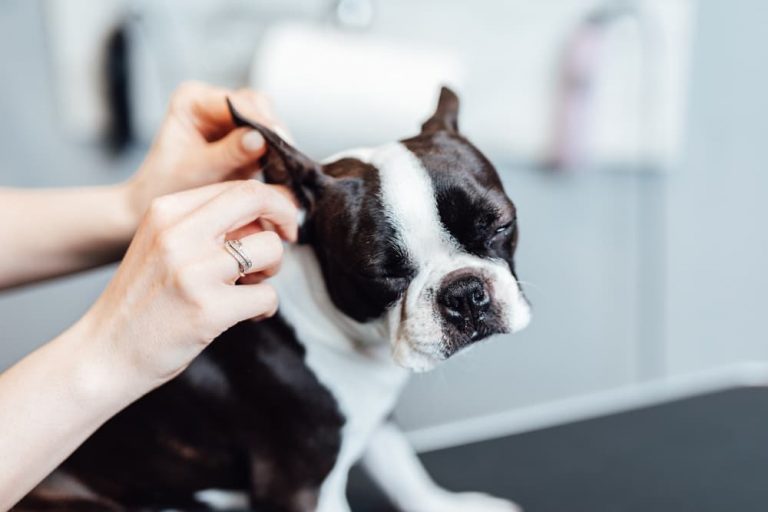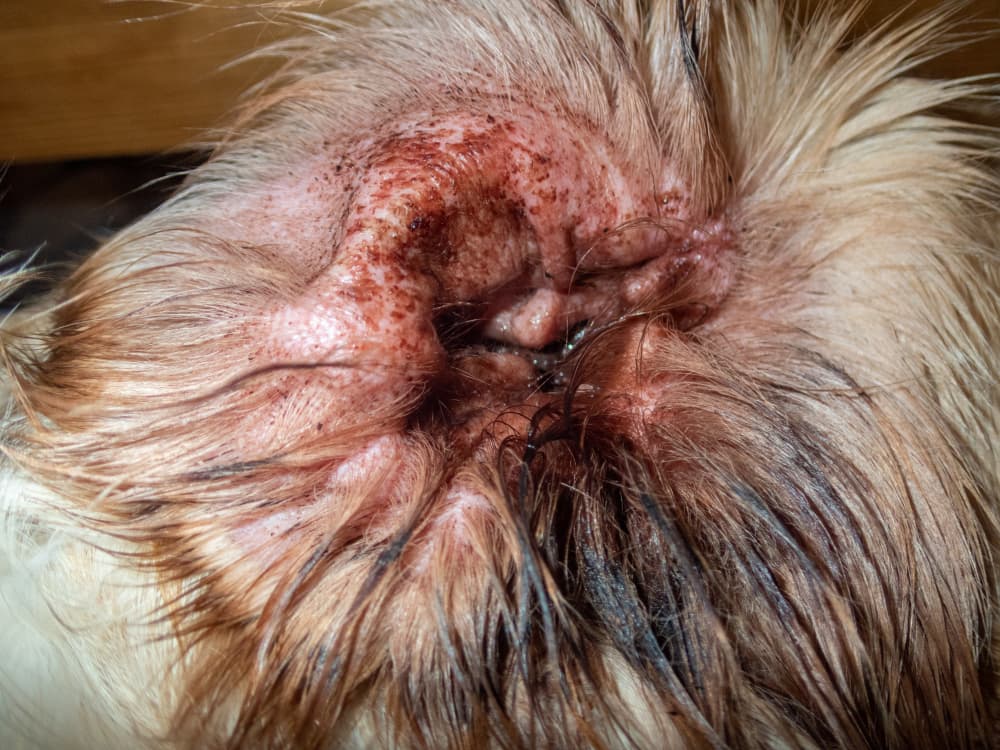Dog Ear Infection: Causes and How to Help

Overview
If your dog has an ear infection, they are probably feeling pretty miserable. Like humans, a dog ear infection can cause symptoms like pain, swelling, and itching. Thankfully, relief can come quickly, since many dog ear infections can easily be treated by your dog’s vet.
According to Dr. Annette Louvier, veterinarian with Wisdom Health Genetics, ear infections can be broken into three different categories: otitis externa (infection of the external canal), otitis media (middle canal), and otitis interna (internal canal).
“While otitis externa is the most common, otitis media and interna are often due to the spread of otitis externa,” says Dr. Louvier. “Because infections of the middle and inner ear can be rather serious, not to mention painful, it’s important to treat any ear infection early and to prevent it when possible.”
If you suspect your dog has an ear infection, we’ve got you covered on the signs of ear infection in dogs, causes of dog ear infections, and how to clean a dog’s ears to prevent ear infections from developing.
What Causes a Dog Ear Infection?
One of the main reasons dogs frequently get ear infections is because of the shape of the ear canal.
“A dog’s ear canal is shaped like that of the letter L, which is unfortunately great for holding moisture and creating an environment which allows bacteria and yeast overgrowth,” says Dr. Louvier. “So when mixed with other factors—either internal, like allergies and hormone disorders, or external, such as injury or foreign bodies—then it makes the dog vulnerable to ear infections.”
Types of Ear Infections in Dogs

Not all ear infections are caused by the same thing. There are three main types: parasitic, bacterial, and fungal.
Parasite Ear Infections: Parasitic ear infections are usually caused by ear mites. “Ear mites cause itch and irritation, which primes the ear canals for secondary bacterial and yeast infections,” says Dr. Louvier. “This type of infection most often occurs in young puppies.”
Bacterial Ear Infections: Bacterial infections are typically made up of opportunistic bacteria which commonly live on the skin in low levels. “While bacteria alone won’t cause an ear infection, things such as moisture and inflammation will allow the bacteria to take hold,” says Dr. Louvier. “And once that happens, the bacteria will multiply and push the cycle of inflammation forward to a full blown ear infection.”
Fungal Ear Infections: Yeast is the biggest cause of fungal ear infections. Yeast naturally lives on your pup’s skin. “However, when in the proper environment, yeast populations will increase and perpetuate inflammation leading to an ear infection,” says Dr. Louvier.
Other Causes of Ear Infections in Dogs
Things like allergies, foreign objects and tumors can directly cause inflammation, allowing secondary bacterial and yeast infections.
And those cute floppy ears may be another cause. “Some breeds have large ear flaps that may trap moisture, while others have hair within the canals that sometimes hold humidity,” adds Dr. Louvier. Some examples of breeds more prone to ear infections include Basset Hounds, Beagles, Labrador Retrievers, and Cocker Spaniels.
Symptoms of Ear Infections in Dogs

If your pup has an ear infection, their behavior will probably be a dead giveaway that something’s wrong.
“Because ear infections are painful, many dogs will scratch and shake their head in attempts to provide relief,” says Dr. Louvier.
You also may notice physical signs on or inside your dog’s ears.
“Additionally, the ears will become red due to inflammation, and often there will be an increase in either yellow or dark/black discharge which can be accompanied by an odor. In some cases skin crusting may also occur,” says Dr. Louvier.
She adds that for dogs with chronic or frequently recurring infections, the ear canals may become thickened and narrow due to the persistent inflammation.
Diagnosing Ear Infections in Dogs
To officially diagnose your pup with an ear infection, your vet will do a thorough examination of the external ear, as well as use an otoscope to look within the ear canal.
“Veterinarians are looking at the health of the skin, evidence of self-trauma (like scratching), changes of the ear anatomy, discharge and debris, possible foreign objects, visualization of the eardrum (which is very important when it comes time for treatment) and more,” says Dr. Louvier.
She adds that veterinarians will often use a cotton-tipped applicator to make a smear of the ear debris to review under a microscope.
“These findings can provide quick diagnostic information—such as confirming presence of ear mites and visualizing the overgrowth of bacteria or yeast,” she explains.
In some cases, especially for recurrent or chronic infections, additional testing may be required.
“This can vary depending on physical exam findings, severity of the ear infection, and the type of microorganism causing the infection. Really painful pups may also require sedation to facilitate the exam, testing, and initial treatment (such as flushing out the ear, if necessary),” adds Dr. Louvier.
Dog Ear Infection Treatments

To get your pup feeling better, your vet may prescribe varying treatments depending on the underlying cause and severity of the ear infection.
“For the more common causes of ear infections, topical medications are typically prescribed and tailored towards the type of infection present (bacterial, yeast, etc),” says Dr. Louvier.
However, she explains that the first step in treatment is carefully cleaning the ear canal so that medications can work appropriately. Additionally, some pups may also require removal of hair from within the ear canals—breeds like the Bichon Frise, for instance.
“The use of topical medications is also why it’s important to confirm the health of the eardrum, as some medications can be harmful to the middle and inner ear, so naturally those should be avoided in cases of a ruptured eardrum,” adds Dr. Louvier.
Pet parents should refrain trying to treat dog ear infections with at-home remedies without talking to their veterinarian first.
“Substances used in home remedies, including vinegar dilutions, may not typically cause problems with healthy ear canals,” says Dr. Louvier. “However, these same substances can irritate tissue that’s already inflamed and sometimes even increase discharge secretions which continues the cycle of infection.”
How to Prevent Ear Infections in Dogs

To help keep your dog’s ears healthy, there are things you can do to prevent ear infections from developing. Here are three easy tips to follow:
Inspect Your Dog’s Ears Regularly
Every pet parent knows their furry friend the best, so you are the best resource for picking up on early changes. Plus, catching an infection early provides the best chance of treatment success and helps avoid worsening complications, like spreading to the middle or inner ear.
How to do it: Look at the skin on the ear flap and within the visible portion of the ear canal.
“Things to note include evidence of pain (such as whining or reluctance towards being touched), evidence of scratching, skin redness, increase of moisture, change in odor, increase in debris within the ears, and so on,” says Dr. Lovier. “Any changes indicate it’s time for a checkup.”
Keep Your Dog’s Ears Clean
Paired with regularly inspecting your dog’s ears, cleaning your dog’s ears will help you stay on top of any changes that may be occurring. Ear cleanings also help remove any wax build up that could contribute to worsening issues.
How to do it: Start by checking with your veterinarian for a run down on how to safely clean your dog’s ears at home. Then look for a gentle dog ear cleaner that best suits your dog’s needs. You can buy a dog ear cleaner from a pet supply store or online shop or ask your veterinarian for recommendations.
“Two options include filling the ear canal directly with the cleaning solution or applying the solution via a soaked cotton ball,” says Dr. Louvier. “You would then massage the base of the ear for roughly 30 seconds before allowing your pup to shake their head.”
She then recommends using either a soft towel or dry cotton balls to remove visible debris.
It’s important to avoid using anything that may push debris down further into the ear canal or that could damage the eardrum. This includes cotton-tipped applicators.
Keep Your Dog’s Ears Dry
Keeping your dog’s ear canals dry will prevent the skin from softening. Excessive moisture can impair the skin’s ability to function as a protective barrier against bacteria and yeast.
How to do it: Always do your best to dry your dog’s ears after bathing or swimming. Two helpful tools to accomplish this are drying solutions and cotton balls.
“Your veterinarian can advise you when to and how to apply drying agents properly. This is because drying agents aren’t meant to be used on a frequent basis as it’s possible to dry out the ear too much,” says Dr. Louvier. “That being said—drying agents are great for water-loving dogs and some bath times. At other times, a simple cotton ball placed at the opening of the ears during bathing can help keep the ears dry.”









